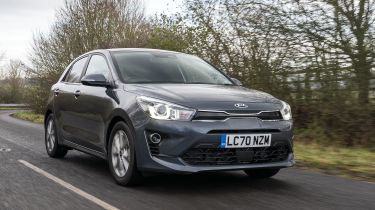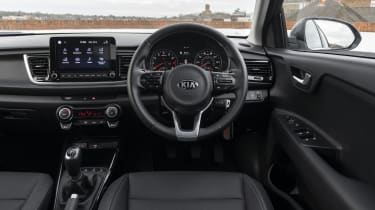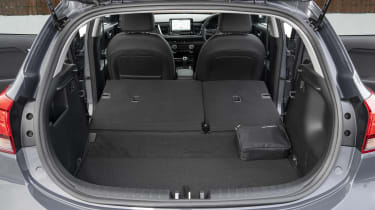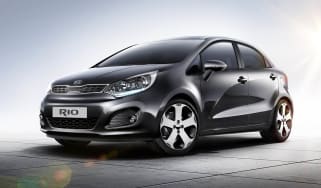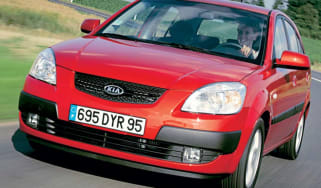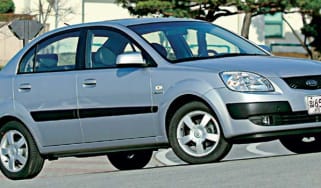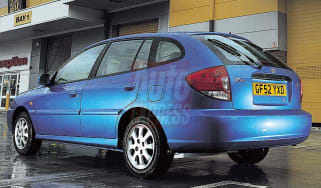Kia Rio (2017-2023) review
The Kia Rio offers good value and practicality - a safe pair of hands in a talented supermini class

The Kia Rio has come on in leaps and bounds since the no-frills original was launched. Unfortunately, the current fourth generation model isn’t a huge step on from the Mk3. It has an evolutionary design inside and out, merely average ride and refinement, and some hard, cheap-feeling interior plastics that all hurt its cause in the hugely competitive supermini class.
That said, the current car is the best version yet and is light years ahead of the Kia Rio Mk1, which was sold as a budget saloon or estate from 2000 to 2005. It just struggles to stand out in today’s market.
About the Kia Rio
To help it stay competitive, Kia mildly updated its Rio towards the end of 2020 with subtle revisions to the styling, infotainment and engine lineup.
These changes haven’t altered the Korean supermini too much, it continues to be reasonable value, offer a high-tech touchscreen infotainment system (from mid-range models and up at least) and promise decent space for passengers.
For now, the 1.0 T-GDi turbo petrol engine with the six-speed manual gearbox is our range highlight, offering strong performance and efficiency. However, the mild-hybrid 1.0 T-GDi 48V petrol engine and “clutch-by-wire” transmission (which were both added in the 2020 updates) could well prove to be the best combination when we sample it on UK roads. The Rio also comes with Kia’s seven-year warranty. It’s just a shame that the firm played it safe with the Rio’s styling, meaning the car fails to stand out visually in this hard-fought sector.
Used - available now

2020 Mercedes
GLA
45,011 milesAutomaticPetrol1.6L
Cash £17,000
2019 Ford
S-Max
72,237 milesAutomaticDiesel2.0L
Cash £15,000
2014 Mazda
3
70,000 milesAutomaticDiesel2.2L
Cash £7,450
2022 Vauxhall
Mokka
52,317 milesManualPetrol1.2L
Cash £13,100While the original Rio stood out for all the wrong reasons, the Rio Mk2 (2005-2011) really established the supermini in a tough market. The Mk3 (2011-2017) picked up where its predecessor left off, albeit in a more stylish fashion, but it still delivered strong fuel economy and plenty of standard equipment.
The Rio Mk4 arrived in 2017, with a design that was an evolution of the Mk3 and more of the tech and quality that supermini buyers have come to expect from these types of car. The exterior featured a more prominent 'tiger nose' grille (which has been made narrower as part of the 2020 revisions), while the interior has improved switchgear and all bar the most basic model come with a touchscreen infotainment system as standard.
The Rio range comprises straightforward 1, 2 and 3 specifications, while the occasional limited edition crops up from time to time. At launch, a First Edition was offered, but GT-Line S has since superseded it as the range-topper.
All cars come with at least air-conditioning, electric heated door mirrors, Bluetooth, auto lights and LED daytime running lights. Moving up to 2 spec cars brings 15-inch alloy wheels, cruise control, rear parking sensors, a reversing camera and an 8.0-inch touchscreen infotainment system.
Go for 3 trim and you get 16-inch alloy wheels, fake leather interior and auto wipers. Range-topping GT-Line S adds 17-inch alloy wheels, various sportier-looking trims, LED headlights, black cloth and fake leather upholstery, front parking sensors and blind-spot monitoring. For reference, First Edition featured 17-inch alloys, keyless entry and LED rear lights. Prices range from £14,000 to around £20,000.
Three engines are offered in the Rio and all are petrol-powered. There is a 1.2-litre four-cylinder and two 1.0-litre turbocharged three-cylinder engines – the latter being called “T-GDi” in Kia-speak. It is only the most powerful three-pot that uses Kia’s 48-volt mild-hybrid system.
You can't get every engine in every trim, with the most powerful 118hp 1.0 T-GDi only coming in 3/GT-Line S trim, and the 99hp version only offered in 2 trim. The 1.2-litre (formerly a 1.25) is only available in trims 1 and 2. An automatic transmission is an option for the two 1.0-litre turbo engines but all Rios are front-wheel-drive.
Diesel isn't as popular as it once was in the supermini sector, and while Kia has previously offered some of the most economical cars on sale – in the form of its CRDi diesel models – the South Korean manufacturer no longer makes a diesel Rio for the UK market. Which is a shame, as the lower-powered diesel was claimed to be capable of more than 80mpg.
There are many supermini rivals to the Kia Rio, and a lot of these have been updated or replaced since the Rio arrived in 2017. Chief among them are the UK's best-selling cars, such as the Ford Fiesta and Volkswagen Polo, while the SEAT Ibiza, Citroen C3, Nissan Micra and Toyota Yaris have come on in leaps and bounds over their predecessors.
Elsewhere, Hyundai (Kia’s sister brand) offers the i20 which is closely related to the Rio. There is also the Mazda 2, which offers sharp looks and a sporty drive, while the Vauxhall Corsa is a great supermini that can sometimes be had at a heavily discounted rate. Finally, Skoda’s Fabia is well worth considering, too.
Engines, performance and drive
The Kia Rio shares much with the Hyundai i20 under its skin, including major components such as the chassis and some powertrains. Kia claims its car has been tuned differently, however, with focus on improving both comfort and driveability.
Unfortunately, the result is a bit of a mixed bag. On the one hand, the Rio handles tidily enough, with good body control in the bends, accurate (but feel-free) steering and decent agility. It lacks the sense of involvement or fun found in the Ford Fiesta, yet it’s acceptable for the class.
The moderately engaging handling comes at the expense of ride comfort and refinement, though. It’s by no means uncomfortable, but the Rio feels quite firm over all but the smoothest surfaces and can get a bit crashy over big bumps. Refinement isn’t all that impressive either: wind noise is kept at bay, but road noise is noticeable on the UK’s poor surfaces. Both these issues only get worse with the larger wheels of top-spec cars. In this respect, it’s no better than the previous generation Kia Rio.
That’s a shame, because around town the Rio is likeable enough, thanks to good all-round visibility, a slick gearshift and light clutch, plus those smooth and nippy engines.
Engines, 0-60 acceleration and top speed
The naturally aspirated four-cylinder 1.2-litre engine is low on power and torque compared to the smaller capacity turbo units. In the real world, this will mean the engine (and five-speed manual gearbox) will have to be worked harder to get the best performance. Sprinting from 0 to 60mph takes quite a while (12.7 seconds to be exact) and top speed is 108mph. Despite the modest performance numbers, the engine is reasonably refined when kept at the slower speeds typical of urban streets.
The mild-hybrid three-cylinder 1.0-litre turbo unit produces just one more brake horsepower than the old (discontinued) 1.4, but significantly more torque at 200Nm. With the engine matched to Kia’s six-speed manual gearbox, such figures translate to a 0 to 60mph time of 9.8 seconds and a top speed of 118mph. Going for an automatic transmission adds 0.1 seconds onto the 0 to 60mph time but does nothing to the top speed.
The non-hybrid 1.0-litre produces 172Nm of torque but only 99bhp. Again using Kia’s six-speed manual ‘box, 0 to 60mph is claimed to take 10.0 seconds and top speed is 115mph. Going for an automatic transmission adds a second onto the 0 to 60mph time and 2mph onto the top speed. The extra torque of the 1.0-litre engines means the Rio can be much more flexible at lower engine speeds, and more refined thanks to the reduced need to rev it out. They aren’t the best three-cylinder turbo engines on the market by any stretch, but it injects some much needed urgency into the Rio’s driving experience.
The last diesel Rios to be offered by Kia came with a 1.4-litre CRDi engine. There were two power outputs to choose from; 76bhp or 89bhp. The latter offered the strongest performance thanks to 250Nm of torque available from just 1,500rpm. Regardless, shifting consumer demands called time on diesel-fuelled Rios in 2020.
MPG, CO2 and running costs
Low running costs are often at the forefront of buyers’ minds when choosing a new supermini, and the Rio excels in that area. It's no longer the cheapest to buy, but it won’t cost the earth to fuel or maintain.
The entry-level 1.2-litre petrol engine manages a claimed 49.6mpg on the WLTP combined cycle and emits 128g/km of CO2 in 1 spec and 130g/km in 2 spec. The 99bhp 1.0-litre petrol fairs slightly better, managing 52.3mpg on the combined cycle (dropping to 50.4 for automatic models). CO2 emissions are 123g/km for manuals and 127g/km for autos.
Mild-hybrid versions don’t bring the improvements in fuel economy and emissions some might expect. 3 grade manual and automatic models are both claimed to be capable of 52.3mpg (identical to some lesser-equipped Rios with no 48-volt hybrid system). A manual gearbox means emitting 122g/km of CO2 while an auto translates to 123g/km.
Range-topping mild-hybrid GT-Line S models perform worse still. Again, the manual and automatic versions are claimed to come with the same fuel economy – 51.4mpg – and again the auto emits 1g/km more CO2 than the manual – 125 vs 126.
Insurance Groups
The Rio ranges from Group 4 to Group 9 for insurance purposes, so it'll be relatively cheap to insure. It is 1 and 2 grade models with the 1.2-litre petrol engine that sit in group 4, while 3 and GT-Line S models sit in group 9.
Depreciation
The Rio's seven-year, 100,000-mile warranty is transferable between owners, which is a real selling point on the second-hand market. However, residual values of around 40 per cent are fairly average in the supermini class.
To get an accurate valuation on a specific model check out our free car valuation tool...
Interior, design and technology
Kia has made no bones about its desire to push the Rio upmarket, tasking its German and Californian design studios with the challenge of injecting its supermini with some premium appeal.
With its solid proportions and smooth curves, the newcomer is clearly a more grown-up proposition than before, but it also looks rather ordinary. Under the skin, the Rio follows the same template as its mainstream rivals. There’s an all-new platform with a longer wheelbase and greater strength, but the chassis features the same strut front suspension and torsion beam rear axle as the Volkswagen Polo.
Climb aboard and it’s clear the brand’s designers have tried to give the cabin a mature look like the exterior. The updates in 2020 brought a few minor trim and material changes but nothing significant. The dashboard features a heavily sculpted design that flows into the doors, while the silver-trimmed climate controls look like they are heavily influenced by those used in Audi’s smaller models. Unfortunately looks are deceptive, and closer inspection of the plastics reveals a hard and brittle finish that’s a long way behind the class best.
Still, there’s lots of kit on the Rio 3, with sat-nav, a heated steering wheel and seats, climate control and a reversing camera. Also included is faux leather trim, but it looks and feels rather low rent.
Sat-nav and infotainment
Entry-level Rio 1 models get a standard radio unit with Bluetooth and USB connectivity. As of October 2020, 2 trim and above come with an eight-inch touchscreen display featuring Apple CarPlay and Android Auto compatibility. Top-spec GT-Line S and 3 trims improve the infotainment system further by adding built-in satellite navigation. Aside from on entry-level 1 spec, all models come with an additional USB charging port in the back – useful for keeping passengers happy.
Practicality, comfort and boot space
The Kia Rio is bigger than its predecessors, so there’s more space inside - although the Rio’s best point is its roomy boot rather than a particularly large cabin.
Storage inside is taken care of by some handily-sized door bins, a large glovebox and a deep centre console cubby that has room for a smartphone, and there's a pair of cupholders, too.
Dimensions and size
The Rio is 5mm wider than before (at 1.73m) and has a 10mm longer wheelbase (2.58m) for more space inside. The car is 15mm longer (at 4.07mm) than the previous model in total, but it’s actually 5mm lower (1.45m) as well. Designers will tell you that contributes to a lower stance, but unfortunately the plain looks don’t do much for the Kia’s image.
Legroom and passenger space
While the Kia boasts impressive luggage space, the interior isn’t quite as roomy as the competition. In fact, our tape measure revealed that there’s around 10mm less legroom in the rear than the Volkswagen Polo, and a massive 100mm less than in the Suzuki Baleno. That said, there’s enough space to carry four adults in reasonable comfort, while the wide-opening doors make access straightforward. There’s plenty of space up front, with the driver also getting a reasonable range of seat and wheel adjustment.
Boot space
An increase in length by 15mm and a 10mm stretch in wheelbase over the old car have helped make the Rio one of the more practical models in the class. For example, the boot now has a healthy 325-litre capacity. The load bay is well shaped, too, with a reasonably wide opening and small lip.
Reliability and safety
Kia has worked hard to shake off its budget brand image, and on the evidence of its recent Driver Power performances, it’s clear these efforts are paying off. For example, the brand finished an impressive 2nd in our 2020 survey – bested only by Lexus. The Rio itself was voted the 23rd best car to own (out of 75).
The Rio also boasts impressive safety credentials, with stability control, six airbags and impact-sensing door unlocking featuring on all models. Euro NCAP rated the Rio with a three-star score in basic form in 2017, but adding Kia's Advanced Driving Assistance Pack (ADAP) raises this to the full five stars. It's worth noting that Rio 2 and above come with ADAP as standard, and this includes autonomous braking and a lane departure warning.
Warranty
The Kia Rio comes with a seven-year/100,000-mile warranty, just like all other models from the brand. That means it’s best-in class in this area, handily beating the three-year period you get as standard on most rival superminis. It was a huge selling point for the previous car, and continues to be for this model - especially as there’s not much else that the Rio stands out for.
Servicing
Service intervals are 12 months or 10,000 miles, whichever comes sooner. Kia does offer servicing plans and they are called Care 1-2, Care 1-3 and Care 1-5 – they last 2, 3 and 5 years respectively. With regard to costs, it depends on which engine is under the bonnet but even so the prices don’t change by much.
As an example, a two-year service plan for 99bhp petrol models costs £329, increasing this to a three-year package would be an extra £130 and going the whole hog and purchasing a five-year plan would be £839 in total. MOTs can be added for an additional £35 per test as well. Handily, the packages are transferable to the new owner if you sell the car.

